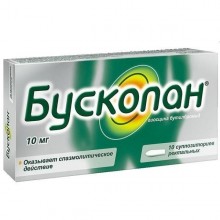



Blocker of m-cholinergic receptors.
It has a local antispasmodic effect on the smooth muscles of internal organs (gastrointestinal tract, biliary tract, urinary tract), reduces the secretion of digestive glands.
Local antispasmodic effect due to ganglioblokiruyuschimi and m-anticholinergic activity of the drug.
Being a quaternary ammonium derivative, Hyoscine butylbromide does not penetrate the BBB, so there is no anticholinergic effect on the central nervous system.
1 suppository contains:
Active substances: Hyoscine butylbromide - 10 mg.
Excipients: purified water - 10 mg, solid fat W45 - 1610 mg.
Hyoscine butylbromide is marketed under different brands and generic names, and comes in different dosage forms:
| Brand name | Manufacturer | Country | Dosage form |
|---|---|---|---|
| Buscopan | Institute de Angeli S.R.L | Austria | rectal suppositories |
| Buscopan | Delpharm Reims | Austria | pills |
No customer reviews for the moment.
Rectal (suppositories), unless otherwise specified, for adults and children over 6 years old - 1–2 supp. 3 times a day.
Suppositories should be removed from the shell and injected into the rectum with a pointed end forward.
The duration of use is determined by the doctor.
Side effects associated with anticholinergic drug action: dry mouth, dry skin, tachycardia, drowsiness, accommodation paresis; difficulty urinating is possible (usually weakly expressed and passes independently).
Allergic reactions: skin rash.
In rare cases: difficulty breathing
Buscopan can enhance the anticholinergic effect of tricyclic and tetracyclic antidepressants, antihistamines, antipsychotics, quinidine, amantadine, disopyramide, anticholinergics (eg, tiotropium bromide, ipratropium bromide, atropine-like compounds).
The simultaneous use of the drug Buscopan® and dopamine antagonists (for example, metoclopramide) leads to a weakening of the effects on the gastrointestinal tract of both drugs.
Buscopan may increase tachycardia caused by beta-adrenomimetics.
Currently there are no data on the negative effect of the drug on the fetus. However, during pregnancy (especially in the first trimester), the drug should be prescribed with caution.
The safety of the drug during lactation has not been established. However, cases of adverse effects in newborns are not reported.
The drug should be prescribed with caution in the following clinical situations: suspected intestinal obstruction (including pyloric stenosis); obstruction of the urinary tract (including benign prostatic hyperplasia), tachyarrhythmias (including atrial tachyarrhythmia), angle-closure glaucoma.
In cases where abdominal pain of unknown origin continues or increases, or when symptoms such as fever, nausea, vomiting, changes in stool consistency and frequency of bowel movements, abdominal sensitivity, decreased blood pressure, fainting, or blood in the feces, are noted at the same time for medical advice.
Influence on ability to drive motor transport and control mechanisms
Research on the effect of the drug on the ability to drive vehicles and control mechanisms was not conducted.
Symptoms: urinary retention, dry mouth, redness of the skin, tachycardia, depression of gastrointestinal motility, transient visual disturbances.
Treatment: gastric lavage with activated charcoal and then with 15% magnesium sulfate (with an overdose of pills). Symptoms of overdose are stopped by cholinomimetics.
Patients with glaucoma are locally prescribed pilocarpine in the form of eye drops.
If necessary, cholinomimetics are administered systemically, for example, neostigmine 0.5-2.5 mg IM or IV.
Cardiovascular complications are treated according to the usual therapeutic rules.
When paralysis of the respiratory muscles shows intubation, mechanical ventilation. In case of urinary retention, the bladder is catheterized.
Maintenance therapy is underway.
Studies and clinical trials of Hyoscine butylbromide (Click to expand)